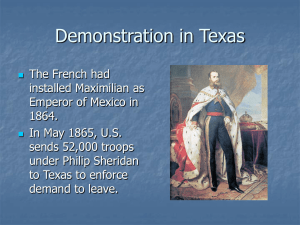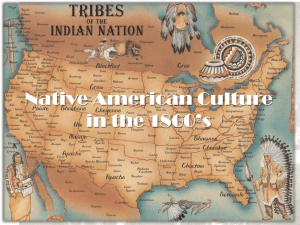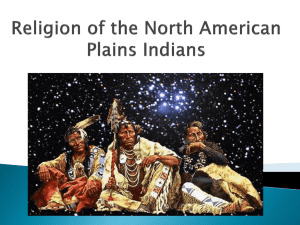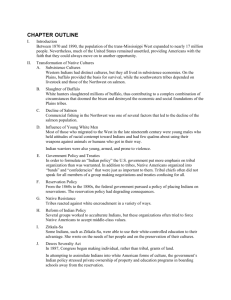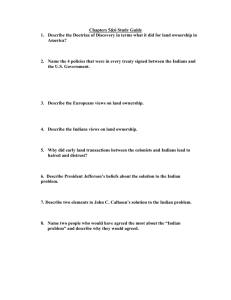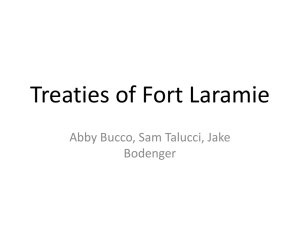Timeline of Major Events and Trends of the Nineteenth Century
advertisement
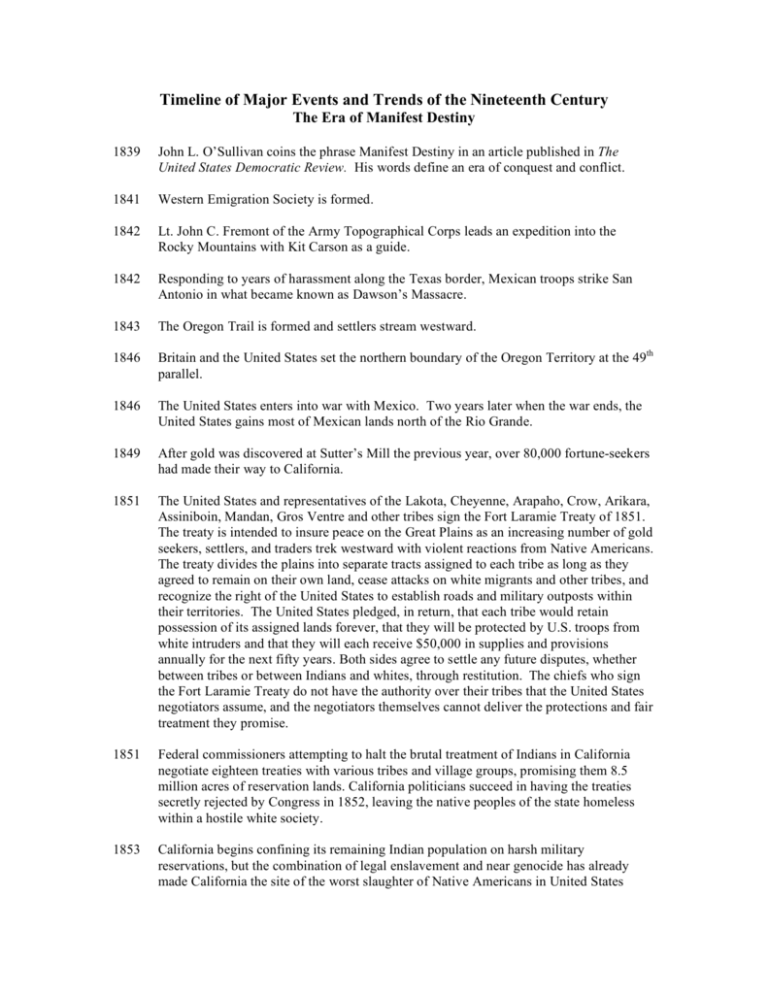
Timeline of Major Events and Trends of the Nineteenth Century The Era of Manifest Destiny 1839 John L. O’Sullivan coins the phrase Manifest Destiny in an article published in The United States Democratic Review. His words define an era of conquest and conflict. 1841 Western Emigration Society is formed. 1842 Lt. John C. Fremont of the Army Topographical Corps leads an expedition into the Rocky Mountains with Kit Carson as a guide. 1842 Responding to years of harassment along the Texas border, Mexican troops strike San Antonio in what became known as Dawson’s Massacre. 1843 The Oregon Trail is formed and settlers stream westward. 1846 Britain and the United States set the northern boundary of the Oregon Territory at the 49th parallel. 1846 The United States enters into war with Mexico. Two years later when the war ends, the United States gains most of Mexican lands north of the Rio Grande. 1849 After gold was discovered at Sutter’s Mill the previous year, over 80,000 fortune-seekers had made their way to California. 1851 The United States and representatives of the Lakota, Cheyenne, Arapaho, Crow, Arikara, Assiniboin, Mandan, Gros Ventre and other tribes sign the Fort Laramie Treaty of 1851. The treaty is intended to insure peace on the Great Plains as an increasing number of gold seekers, settlers, and traders trek westward with violent reactions from Native Americans. The treaty divides the plains into separate tracts assigned to each tribe as long as they agreed to remain on their own land, cease attacks on white migrants and other tribes, and recognize the right of the United States to establish roads and military outposts within their territories. The United States pledged, in return, that each tribe would retain possession of its assigned lands forever, that they will be protected by U.S. troops from white intruders and that they will each receive $50,000 in supplies and provisions annually for the next fifty years. Both sides agree to settle any future disputes, whether between tribes or between Indians and whites, through restitution. The chiefs who sign the Fort Laramie Treaty do not have the authority over their tribes that the United States negotiators assume, and the negotiators themselves cannot deliver the protections and fair treatment they promise. 1851 Federal commissioners attempting to halt the brutal treatment of Indians in California negotiate eighteen treaties with various tribes and village groups, promising them 8.5 million acres of reservation lands. California politicians succeed in having the treaties secretly rejected by Congress in 1852, leaving the native peoples of the state homeless within a hostile white society. 1853 California begins confining its remaining Indian population on harsh military reservations, but the combination of legal enslavement and near genocide has already made California the site of the worst slaughter of Native Americans in United States history. As many as 150,000 Indians lived in the state before 1849; by 1870, fewer than 30,000 will remain. 1853 Mexico agrees to the Gadsden Purchase, selling a strip of land running along Mexico's northern border between Texas and California for $10 million. Intended as the route for a railroad connecting the Mississippi to the Pacific, the territory goes undeveloped when the approach of the Civil War causes the project to be put aside. 1854 After much bitter debate, Congress approves the Kansas-Nebraska Act, which repeals the Missouri Compromise of 1820 by allowing these two territories to choose between slavery and free soil. 1859 Gold is discovered in Boulder Canyon, Colorado, sparking the Pikes Peak gold rush which brings an estimated 100,000 fortune-hunters to the Rockies under the banner "Pikes Peak or Bust." 1860 A Homestead Bill, providing federal land grants to Western settlers, is vetoed by President Buchanan under pressure from the South. The veto divides Buchanan's Democratic party, clearing the way for Abraham Lincoln's election in a three-way race. 1861 Colorado and Nevada Territories are organized as Congress begins to consolidate federal control over the West, establishing strong local governments loyal to the Union across the region. 1861 Crews working to complete a coast-to-coast telegraph line meet at Fort Bridger in Utah Territory. Completion of a transcontinental telegraph line signals the end for the Pony Express. 1861 Confederate forces fire on Fort Sumter in Charleston, South Carolina, unleashing the Civil War. 1861 The Kansas Jayhawkers, a supposedly pro-Union guerrilla band organized by Charles J. Jennison, begin marauding across the Missouri border. In December, they attack and occupy Independence, Missouri, burning much of the city and killing many citizens. 1862 Congress passes the Pacific Railroad Act, which authorizes the Central Pacific and Union Pacific Companies to build a transcontinental rail line along the 42nd parallel and provides public lands and subsidies for every mile of track laid. 1862 Congress passes the Homestead Act, which allows citizens to settle on up to 160 acres of surveyed but unclaimed public land and receive title to it after making improvements and residing there for five years. Acts that are friendly to the needs of the North pass easily through a Congress with little Southern representation. 1862 The Civil War divides the Five Civilized Tribes, who brought slaves west with them when they were forced from their homelands in the South. Most side at once with the Confederacy, contributing a brigade to the cause. But the Creek Nation splits into proUnion and pro-Confederate factions, who battle against one another throughout the war. 1862 Sibley's Brigade, an army of Texas Confederates commanded by General Henry J. Sibley, invade New Mexico, moving up the Rio Grande. They defeat a Union force at Valverde, advance through Albuquerque and Santa Fe, and then turn north toward Colorado's gold fields. But at Apache Canyon they are ambushed by a squad of Colorado volunteers commanded by the "Fighting Parson," John M. Chivington, and two days later they are defeated by a Union force at Glorietta Pass, where Chivington's irregulars rappel down a cliff face to destroy their supply wagons. The Texans retreat in disarray, their hopes of conquest shattered at "the Gettysburg of the West." 1863 President Lincoln issues the Emancipation Proclamation. 1863 Union forces prevail at the Battle of Gettysburg. 1864 Quantrill's Raiders, a Confederate guerrilla band operating out of Missouri, terrorize Lawrence, Kansas, killing 150 residents and burning much of the town. Among the Raiders are Frank and Jesse James, and Cole and Jim Younger, who will use the hit-andrun tactics taught by their leader, William Clarke Quantrill, to create vicious outlaw gangs in the post-war West. 1864 Congress organizes the Montana Territory and admits Nevada into the union, completing the political organization of the West under local governments loyal to the Union. 1864 A second Pacific Railroad Act is passed by Congress, one that aims to stimulate investment in the enterprise by doubling the size of the land grants and improving the subsidies offered for every mile of track laid. 1864 Sent to punish Navajo raiding parties in northwest New Mexico, Colonel Kit Carson leads a campaign of destruction by burning crops and killing livestock. When the Navajo surrender, he marches 8,000 of the tribe on a grueling "Long Walk" across New Mexico to a parched reservation on the Pecos River, where they are held as prisoners of war until 1868. 1864 Meeting with army officers at Fort Weld outside Denver, the Cheyenne chief, Black Kettle, agrees to lead his people back to their Sand Creek reservation in order to restore peace after Indian raids on ranches in the area. He is attacked there by a volunteer force led by John M. Chivington, the "Fighting Parson" of Glorietta Pass, which sweeps down on the Cheyenne encampment at dawn and massacres nearly two hundred men, women and children. Later Congressional and military investigations condemn the slaughter. 1865 The Confederate surrender at Appomattox Courthouse, Virginia, brings an end to the Civil War. 1866 General Philip H. Sheridan takes command of U.S. forces in the West, proposing to bring peace to the plains by exterminating the herds of buffalo that support the Indians' way of life: "Kill the buffalo and you kill the Indians," he says. 1866 A Lakota war party led by Chief Red Cloud attacks a wagon train bringing supplies to newly-constructed Fort Phil Kearny on the Powder River in northern Wyoming. The Lakota see the fort, situated to protect travel to Montana mining country along the Bozeman Trail, as a threat to their territory. When a patrol led by Captain William J. Fetterman rides out to drive off the war party, it is lured far from the fort and destroyed to the last man. 1866 Charles Goodnight and Oliver Loving blaze the first cattle trail, driving a herd of 2,000 longhorns from Texas to New Mexico in what will become an annual tradition across the southern plains. 1867 The first cattle drive from Texas up the Chisholm Trail arrives at the railyards of Abilene, Kansas. 1867 The United States and representatives of the Comanche, Kiowa, Cheyenne, Arapaho and other southern Plains tribes sign the Medicine Lodge Treaty, intended to remove Indians from the path of white settlement. The treaty marks the end of the era in which federal policymakers saw the Plains as "one big reservation" to be divided up among various tribes. Instead, the treaty establishes reservations for each tribe in the western part of present-day Oklahoma and requires them to give up their traditional lands elsewhere. In exchange, the government pledges to establish reservation schools and to provide resident farmers who will teach the Indians agriculture. This same principle of restricting the Plains tribes to reservations will help shape the Fort Laramie Treaty of 1868. In both cases, the tribes' refusal to give up their free-ranging traditions and remain confined within the territory assigned to them leads to devastating warfare. 1868 Chief Red Cloud and General William Tecumseh Sherman sign the Fort Laramie Treaty, which brings an end to war along the Bozeman Trail. Under terms of the treaty, the United States agrees to abandon its forts along the Bozeman Trail and grant enormous parts of the Wyoming, Montana and Dakota Territories, including the Black Hills, to the Lakota people as their exclusive territory. 1868 General Philip Sheridan sends Colonel George Armstrong Custer against the Cheyenne, with a plan to attack them during the winter when they are most vulnerable. Custer's troops locate a Cheyenne village on the Washita River in present-day Oklahoma. The village is home to Black Kettle and his people, the victims of the Sand Creek Massacre in 1864. Custer's cavalry attacks at dawn, killing more than 100 men, women and children, including Black Kettle. 1869 A Golden Spike completes the transcontinental railroad at Promontory Point, Utah. 1870 Buffalo hunters begin moving onto the plains, brought there by the expanding railroads and the growing market for hides and meat back east. In little more than a decade, they reduce the once numberless herd to an endangered species. 1871 More than 100 Apaches -- most of them women and children -- are murdered outside Camp Grant, Arizona, where they had been given asylum, when members of the Tucson Committee of Public Safety arrive with a force of Papago Indians, the Apaches' long-time enemies. The committee members claim they acted in retaliation for raids by various Apache bands at distant points across the region, but public opinion, particularly in the East, links the event to the recently investigated Sand Creek Massacre of 1864 as further evidence of Westerners' deep-seated hatred for Indians. 1871 Congress approves the Indian Appropriations Act, which ends the practice of treating Indian tribes as sovereign nations by directing that all Indians be treated as individuals and legally designated "wards" of the federal government. The act is justified as a way to avoid further misunderstandings in treaty negotiations, where whites have too often wrongly assumed that a tribal chief is also that tribe's chief of state. In effect, however, the act is another step toward dismantling the tribal structure of Native American life. 1873 Although federal authorities estimate that hunters are killing buffalo at a rate of three million per year, President Grant vetoes a law protecting the herd from extermination. 1874 George Armstrong Custer announces the discovery of gold in the Black Hills of Dakota, setting off a stampede of fortune-hunters into this most sacred part of Lakota territory. Although the 1868 Fort Laramie Treaty requires the government to protect Lakota lands from white intruders, federal authorities work instead to protect the miners already crowding along the path Custer blazed for them, which they call "Freedom's Trail" and the Lakota call "Thieve's Road." 1875 The Lakota War – A Senate commission meeting with Red Cloud and other Lakota chiefs to negotiate legal access for the miners rushing to the Black Hills offers to buy the region for $6 million. But the Lakota refuse to alter the terms of the 1868 Fort Laramie Treaty, and declare they will protect their lands from intruders if the government won't. 1876 Federal authorities order the Lakota chiefs to report to their reservations by January 31. Sitting Bull, Crazy Horse and others defiant of the American government refuse. General Philip Sheridan orders General George Crook, General Alfred Terry and Colonel John Gibbon to drive Sitting Bull and the other chiefs onto the reservation through a combined assault. On June 17, Crazy Horse and 500 warriors surprise General Crook's troops on the Rosebud River, forcing them to retreat. On June 25, George Armstrong Custer, part of General Terry's force, discovers Sitting Bull's encampment on the Little Bighorn River. Terry had ordered Custer to drive the enemy down the Little Bighorn toward Gibbon's forces, who were waiting at its mouth, but when he charges the village Custer discovers that he is outnumbered four-to-one. Hundreds of Lakota warriors overwhelm his troops, killing them to the last man, in a battle later called Custer's Last Stand. News of the massacre shocks the nation and Sheridan floods the region with troops who methodically hunt down the Lakota and force them to surrender. Sitting Bull, however, eludes capture by leading his band to safety in Canada. 1876 Colorado enters the Union. 1876 Crazy Horse finally surrenders to General George Crook at Fort Robinson, Nebraska, having received assurances that he and his followers will be permitted to settle in the Powder River country of Montana. Defiant even in defeat, Crazy Horse arrives with a band of 800 warriors, all brandishing weapons and chanting songs of war. By late summer, there are rumors that Crazy Horse is planning a return to battle, and on September 5 he is arrested and brought back to Fort Robinson, where, when he resists being jailed, he is held by an Indian guard and killed by a bayonet thrust from a soldier. 1877 Congress votes to repeal the 1868 Fort Laramie Treaty and take back the Black Hills, along with 40 million more acres of Lakota land. 1877 With the threat of Indian attack removed, mining camps and boom towns -- French Creek, Whitewood Gulch, Black Tail Gulch -- crowd the Black Hills. 1877 Chief Joseph, leader of the Nez Percé, surrenders to General Oliver Howard, bringing to an end his four-month-long circuitous retreat from the Wallowa Valley in eastern Oregon toward Sitting Bull’s encampment in Canada -- one of the most remarkable military feats of the Indian Wars. Eluding or defeating army troops at every turn, Joseph and a band of fewer than 200 warriors bring nearly 500 women and children over 1,500 miles of mountainous terrain to within forty miles of the border before they are finally stopped by a force of 500 troopers led by Colonel Nelson A. Miles. Reduced by this time to just 87 men, Joseph still holds out for five days in a pitiless snowstorm, and then surrenders only because his people have no food or blankets and will soon die of cold and starvation. "I am tired of fighting," he declares as he holds out his rifle to General Howard. "I want to have time to look for my children, and see how many of them I can find. Maybe I shall find them among the dead. Hear me, my chiefs! I am tired. My heart is sick and sad. From where the sun now stands I will fight no more forever." 1879 The first students, a group of 84 Lakota children, arrive at the newly established United States Indian Training and Industrial School at Carlisle, Pennsylvania, a boarding school founded by former Indian-fighter Captain Richard Henry Pratt to remove young Indians from their native culture and refashion them as members of mainstream American society. Over the next two decades, twenty-four more schools on the Carlisle model will be established outside the reservations, along with 81 boarding schools and nearly 150 day schools on the Indians’ own land. 1881 Sitting Bull returns from Canada with a small band of followers to surrender to General Alfred Terry, the man who five years before had directed the campaign that ended in the Lakota Chief’s victory at Little Bighorn. After insulting his old adversary and the United States, Sitting Bull has his young son hand over his rifle, saying, "I wish it to be remembered that I was the last man of my tribe to surrender my rifle. This boy has given it to you, and he now wants to know how he is going to make a living." 1881 Helen Hunt Jackson publishes A Century of Dishonor, the first detailed examination of the federal government’s treatment of Native Americans in the West. Her findings shock the nation with proof that empty promises, broken treaties and brutality helped pave the way for white pioneers. 1881 Late summer brings the last big cattle drive to Dodge City. With livestock plentiful on the plains, the long trek up the Western Trail is no longer profitable, and most states now prohibit driving out-of-state cattle across their borders. The increasing use of barbed wire to enclose farms and grazing land has ended the era of the open range. In the fifteen years since Texas cowboys first hit the trail, as many as two million longhorns have been driven to market in Dodge. 1883 A delegation of U.S. Senators meets with bitter resistance from Sitting Bull when they propose opening part of the Lakota's reservation to white settlers. Despite the old chief's objections, the land transfer proceeds as planned. 1883 Buffalo hunters gather on the northern Plains for the last large buffalo kill, among them a Harvard-educated New York assemblyman named Theodore Roosevelt, who hopes to bag a trophy before the species disappears. Hunters have already destroyed the southern herd, and by 1884, except for small domestic herds kept by sentimental ranchers, there are only scattered remnants of the animal that more than any other symbolizes the American West. 1883 A group of clergymen, government officials and social reformers calling itself “The Friends of the Indian” meets in upstate New York to develop a strategy for bringing Native Americans into the mainstream of American life. Their decisions set the course for U.S. policy toward Native Americans over the next generation and result in the near destruction of Native American culture. 1886 Geronimo, described by one follower as “the most intelligent and resourceful...most vigorous and farsighted” of the Apache leaders, surrenders to General Nelson A. Miles in Skeleton Canyon, Arizona, after more than a decade of guerilla warfare against American and Mexican settlers in the Southwest. The terms of surrender require Geronimo and his tribe to settle in Florida, where the Army hopes he can be contained. 1887 Congress passes the Dawes Severalty Act, imposing a system of private land ownership on Native American tribes for whom communal land ownership has been a centuries-old tradition. Individual Indians become eligible to receive land allotments of up to 160 acres, together with full U.S. citizenship. Tribal lands remaining after all allotments have been made are to be declared surplus and sold. Proponents of the law believe that it will help speed the Indians’ assimilation into mainstream society by giving them an incentive to live as farmers and ranchers, earning a profit from their own personal property and private initiative. Others see in the law an opportunity to buy up surplus tribal lands for white settlers. When the allotment system finally ends, Indian landholdings are reduced from 138 million acres in 1887 to 48 million acres in 1934. And with their land many Native Americans lose a fundamental structuring principle of tribal life as well. 1889 Wovoka, a Paiute holy man, awakes from a three-day trance to teach his tribe the Ghost Dance, with which they can restore the earth to the way it was before the whites arrived in the West. His teachings will soon touch many tribes across the West, stirring a spiritual revival that whites nervously misinterpret as a return to hostilities. 1889 President Benjamin Harrison authorizes opening unoccupied lands in the Indian Territory to white settlement, an order put into effect on April 22 at noon, when a gunshot gives settlers the signal to cross the border and stake their claims. Within nine hours, the Oklahoma Land Rush transforms almost two million acres of tribal land into thousands of individual land claims. 1890 Congress establishes the Oklahoma Territory on unoccupied lands in the Indian Territory, breaking a 60-year-old pledge to preserve this area exclusively for Native Americans forced from their lands in the east. 1890 Wyoming enters the Union. 1890 Sitting Bull is murdered in a confrontation at the Standing Rock Reservation when Lakota policemen attempt to arrest him as part of a federal crackdown on the Ghost Dance. 1890 Federal troops massacre the Lakota Chief Big Foot and his 350 followers at Wounded Knee Creek on the Pine Ridge Reservation in a confrontation fueled by the government’s determination to stop the spread of the Ghost Dance among the tribes. The incident stands in U.S. military history as the last armed engagement of the Indian Wars. 1892 Under the Dawes Act, nearly two million acres of Crow tribal land is opened to settlers in Montana. 1893 Experts estimate that fewer that 2,000 buffalo remain of the more than 20 million that once roamed the Western plains. 1893 More than 100,000 white settlers rush into Oklahoma's Cherokee Outlet to claim six million acres of former Cherokee land. 1894 Frederick Jackson Turner, a 31-year-old instructor at the University of Wisconsin, declares the closing of the Western frontier in his seminal lecture, The Significance of the Frontier in American History, delivered at a meeting of the American Historical Association held in conjunction with the Chicago Columbian Exposition. Timeline is comprised from information found at http://www.mtholyoke.edu/acad/intrel/osulliva.htm and http://www.pbs.org/weta/thewest/events/.

